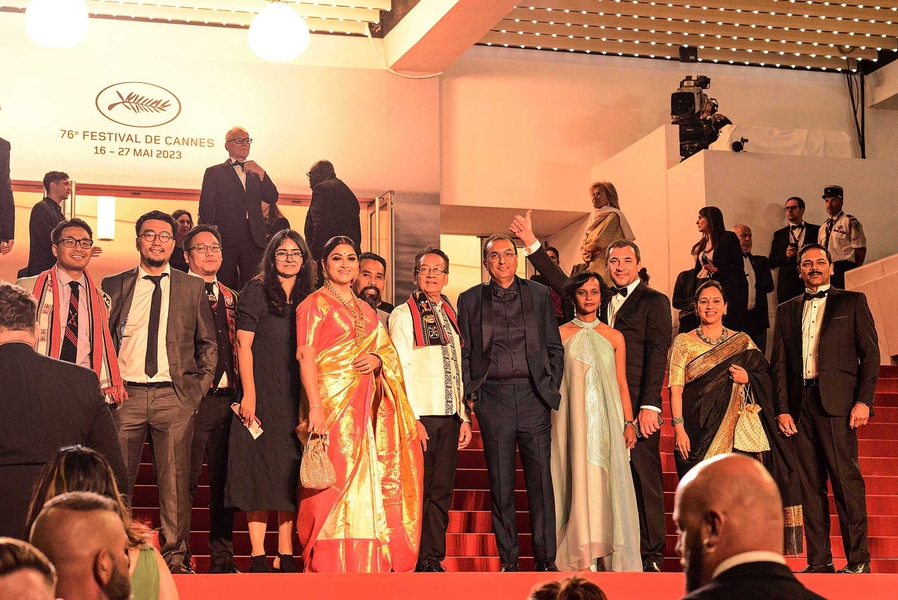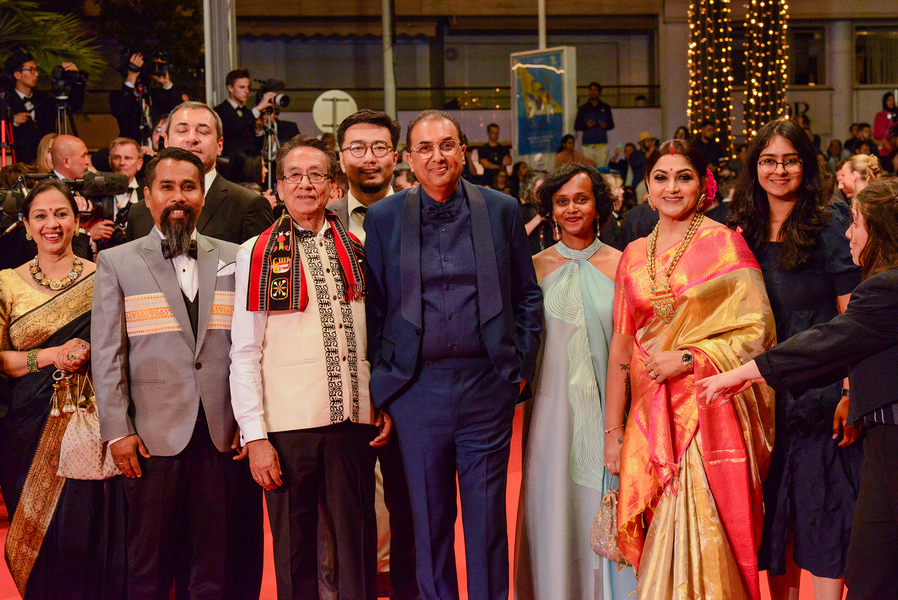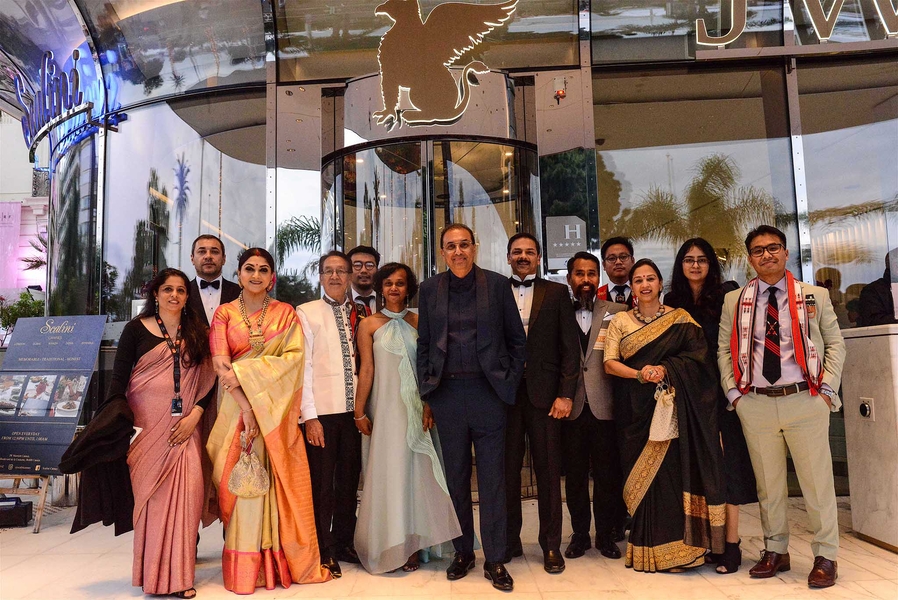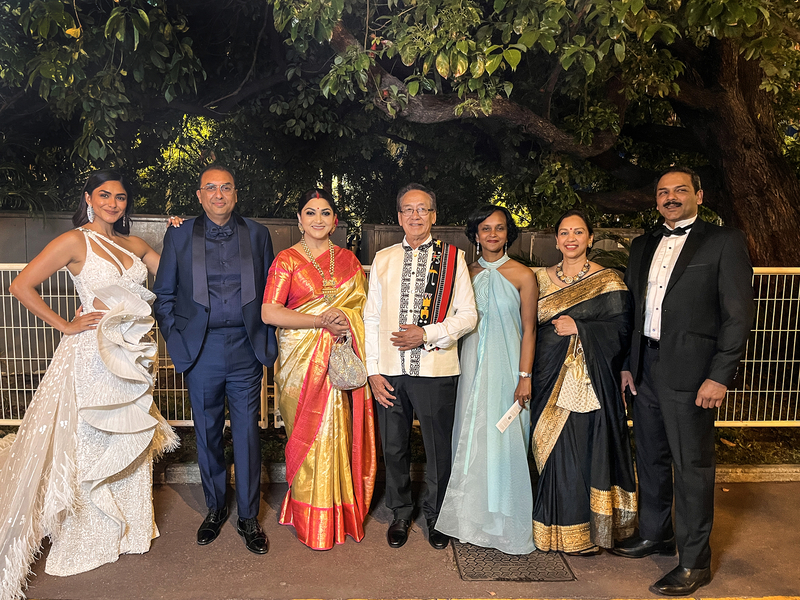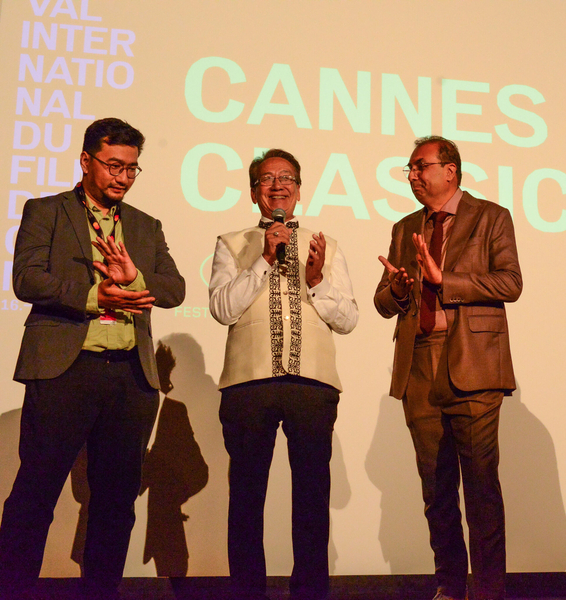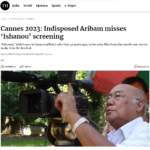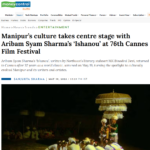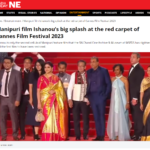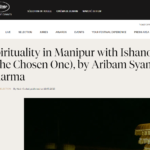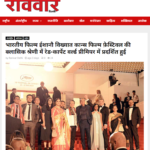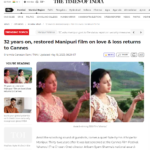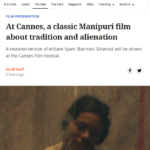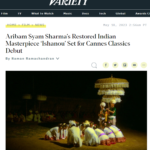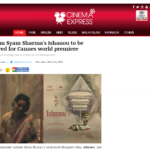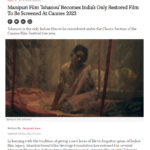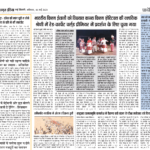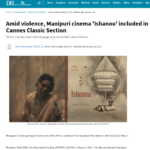In keeping with its policy to restore and give new life to forgotten gems of India’s film heritage, Film Heritage Foundation has restored the revered Manipuri filmmaker Aribam Syam Sharma’s award-winning film “Ishanou” (1990). The restoration has been selected for a red-carpet world premiere at the prestigious Cannes Classic section of the Cannes Film Festival 2023. The restored film was screened on Friday, May 19th, 2023 at 11 a.m. at the Buñuel Theatre.

SHIVENDRA SINGH DUNGARPUR
FILMMAKER, ARCHIVIST AND DIRECTOR, FILM HERITAGE FOUNDATION
“It is fantastic that “Ishanou” is returning to Cannes in all its glory, 32 years after it was screened at the Cannes Film Festival in 1991. Film Heritage Foundation is so proud that our restoration of “Ishanou” has been selected for a world premiere at the Cannes Film Festival 2023 and that we are returning to Cannes for the second year in a row after the success of our restoration of Aravindan Govindan’s film “Thamp” that premiered at Cannes last year. It has been a challenging journey, but the result has been more than worth it. The beautiful restoration will remind the world of the work of a true artist like Aribam Syam Sharma, and give new life to an almost forgotten gem of India’s film heritage from Manipur.
The first time I saw “Ishanou” was in April 2021 when I was in Imphal, Manipur with the Film Heritage Foundation team for a very special project to help the Manipur Government set up a film archive there. One evening in Imphal, I attended a screening of “Ishanou”. I was excited as they were screening a 35 mm print of the film, which has become such a rarity these days. I also had the privilege to meet the director, Aribam Syam Sharma, a doyen of Manipuri cinema and a Renaissance man.
When the film began, I could see the print was not in the best of conditions with scratches and flicker and uneven colours that disturbed the eye. Yet the beauty of the film and the simple yet powerful narrative rooted in the unique culture of Manipur, transcended the distortions that marred the artistry of the imagery playing out on the big screen and I was just mesmerized by the poignancy of the story of a young mother torn between her family and the call of the divine. I was determined that “Ishanou” must be restored to its former glory and that the world should be reminded of a filmmaker who had put Manipuri cinema on the world map.”
ARIBAM SYAM SHARMA
DIRECTOR AND PRODUCER, ISHANOU
I am so glad that Film Heritage Foundation chose “Ishanou” to be restored. It has been a learning experience for me to understand the meticulous process of restoring this film like a work of art, a process that has taken almost a year. I have seen the time and painstaking effort put in by Shri Shivendra Singh Dungarpur of Film Heritage Foundation to work closely with me to ensure that the film is restored keeping in mind my original vision. It has been a journey of discovery to work with Film Heritage Foundation and to see my film restored so beautifully and respectfully and given a new life after over thirty years.
“Ishanou” came into being organically and through a natural progression of events. When I look back, I feel Ishanou happened at the right time, even though it was after a gap of ten years since my last feature film “Imagi Ningthem”. M.K. Binodini Devi was keen to write a screenplay based on the life of the Maibis and I had already done a mammoth documentation project on the Lai-Haraoba which gave me the confidence to film “Ishanou”.
This extraordinary pull or quiet inner urge of the chosen one to abandon the home and immerse oneself in the Maibi culture may seem bizarre, but it is very real. And in this tragic sacrifice lies the sublime art of performance – song and dance attuned to elevate souls beyond the mundane. A chosen one undergoes extraordinary experiences and the experiences shown in the film are based on experiences related by the Maibis to M.K. Binodini Devi. The music that I have used in Ishanou is the traditional music of Manipur, the creators of which have been long forgotten with the passage of time but which has become a common treasure of Manipur. Perhaps, Manipuri culture is the only culture where a whole philosophy of genesis is propagated purely through the performing arts of Lai Haraoba. This unique aspect of Manipuri culture is the mystical canvas against which the human tragedy of the chosen one plays out.
THE RESTORATION PROCESS:
The restoration was a challenging process that took a year. The source film element used for the restoration was the original camera negative on 16 mm that was preserved at the National Film Archive of India (NFAI). When we checked the negative, we realized it was not in good condition. The negative had vinegar syndrome decay on certain reels, mould and warping, broken perforations, scratches, halos on the emulsion and base distortion. Film Heritage Foundation conservators had to work on repairing the negative before it could be scanned at L’Immagine Ritrovata, Bologna, using a wet-gate scanner.
The real challenge was the use of portions of inter-negative in the original camera negative which resulted in wide variations in the image quality, making it very grainy in parts and not matching the other portions of the film. Additionally, there was no sound negative so we had to work on the sound from the two 35 mm prints lying with Aribam Syam Sharma. The sound design in this film is so important paradoxically because of the details in the quietness of the film as well as, of course, the music composed by Aribam Syam Sharma. The film had been shot on 16 mm on a low budget in fluctuating available light conditions as a result of which there were focus and lighting issues that impacted the image.
The manual digital cleanup was done at the Prasad Corporation Pvt. Ltd.’s studios in Chennai while the rest of the restoration workflow including the colour correction and sound restoration was done at L’Immagine Ritrovata, Bologna. Hours of manual work went into the digital restoration, clean-up and colour correction of the film – a process that needed constant coordination between Shivendra Singh Dungarpur in Mumbai, Aribam Syam Sharma in Manipur and the lab technicians in Bologna. The filmmaker himself worked on the subtitling of the film.
RESTORATION CREDITS:
Restored by Film Heritage Foundation at L’Immagine Ritrovata laboratory and Prasad Corporation Pvt. Ltd.’s Post – Studios, Chennai, in association with the Producer and Director, Aribam Syam Sharma and Manipur State Film Development Society.
Ishanou was restored using the best surviving elements: the 16 mm original camera negative preserved at the National Film Archive of India and two 35 mm prints preserved by Aribam Syam Sharma.
The sound was digitised from the 35 mm acetate print and the grading was supervised by Aribam Syam Sharma.
Funding provided by Film Heritage Foundation with the generous support of Dr. Richard Meyer and Susan Harmon.
SYNOPSIS: ISHANOU (THE CHOSEN ONE, 1990):
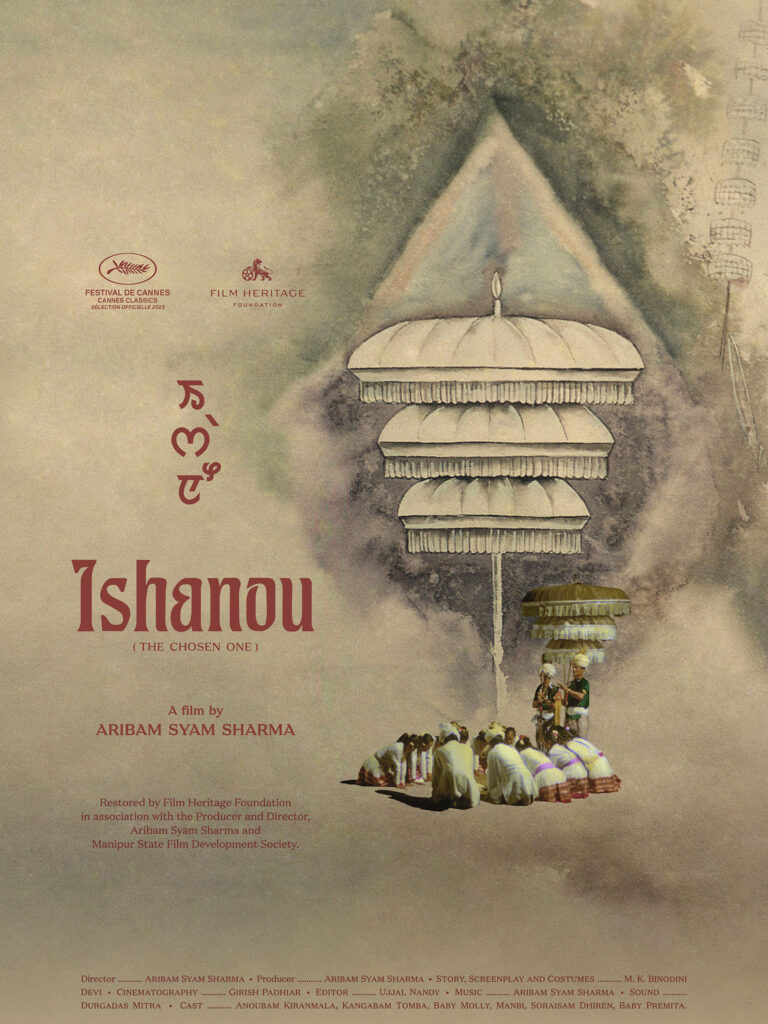
Aribam Syam Sharma’s “Ishanou” is a poignant tale of love and loss steeped in Manipuri culture. The film beautifully juxtaposes the spiritual world of the Maibis with the rhythm of ordinary life, underlining the existence of the occult and the material in the same reality, as the story unfolds to the hypnotic sounds of the Pena (traditional string instrument), the bamboo flute and incantation hymns. The simplicity of the director’s approach, the delicate camerawork and understated acting, coupled with the vivid depiction of the Maibi culture and the use of the traditional music of Manipur in the score composed by the filmmaker, gives the film an authenticity that blends storytelling, documentary and ethnography.
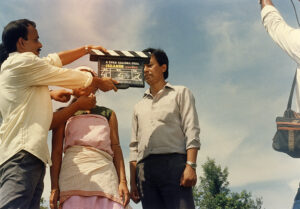

His first love was music he says. Aribam Syam Sharma – singer, composer, actor, theatre director – traversed the path of philosophy, music and drama before crossing the threshold into the world of cinema. The film “Ishanou” (The Chosen One) is a palimpsest reflecting the many talents of this remarkable filmmaker and another gem that emerged from the close collaboration between the filmmaker and the renowned Manipuri writer M.K. Binodini Devi who wrote the screenplay for the film. The film evolved from their shared interest in telling a story based on life of the Maibi sect, Binodini Devi’s observations and stories shared with her by Maibis and Aribam Syam Sharma’s documentary on Lai-Haraoba, an annual ritual festival celebrated by the Meitei community to appease the gods through songs, dance and rituals that are performed by the Maibi.
Tampha, a pretty young woman with a loving husband and a small daughter is leading a tranquil existence in the Manipur valley, occupied with mundane details of life like preparing for her daughter’s ear-piercing ceremony or discussions with her husband about the purchase of a second-hand scooter. Suddenly she begins to behave in a strange manner, talking to flowers, becoming afflicted with dizzy spells and wandering out of the house in the dark of the night. The family runs from pillar to post trying to find a cure for the peculiar malady. Finally, they realize that she does not have an ordinary sickness, but is responding to the inexorable call of the deity. No woman becomes a Maibi by choice; she is chosen by the deity. As if in a dream, Tampha abandons her family to join the Maibi sect of priestesses.

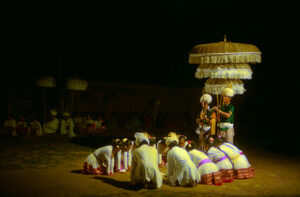
The mysticism of the Maibis with their exquisite costumes and graceful dances enhanced by the ritual singing on the soundtrack suffuses the second half of the film. Aribam Syam Sharma says, “But behind the colourful spectacle of the traditional Manipuri Lai-Haraoba, into which Tampha almost loses herself in enraptured absorption, there lurks the pain of a mother who can no longer nurture a child who now grows into a stranger.” The sad finality of the alienation is brought home at the end of the film which closes with a brief encounter at a festival between Tampha, her estranged husband and grown-up daughter who fails to recognize her, leaving the audience haunted by the anguish and loneliness of the mother – the Chosen One, who had no choice.
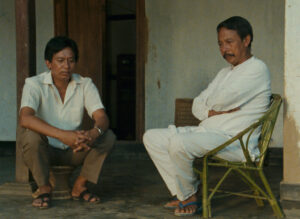
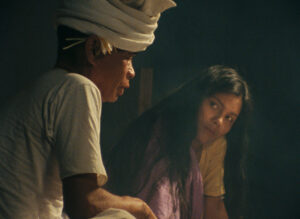
FILM REPAIR STILLS:
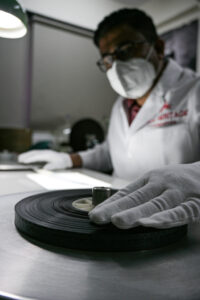



RESTORATION STILLS: BEFORE AND AFTER:


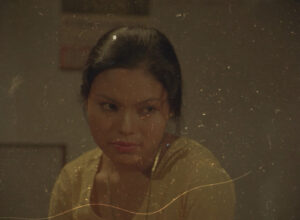

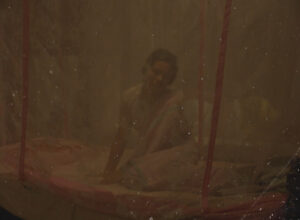
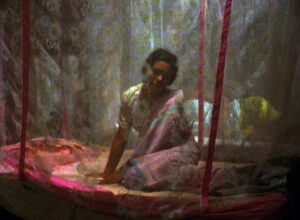
CAST AND CREW DETAILS:
Ishanou (The Chosen One), India, 1990, Aribam Syam Sharma
90 minutes, Colour, Manipuri, English Subtitles, Aspect Ratio 1.37:1
Story, Screenplay and Costumes: M. K. Binodini Devi, Cinematographer: Girish Padhiar, Editor: Ujjal Nandy, Sound: Durgadas Mitra, Music: Aribam Syam Sharma, Production House: Aribam Syam Sharma Productions, Producer: Aribam Syam Sharma
Cast: Anoubam Kiranmala, Kangabam Tomba, Baby Molly, Manbi, Soraisam Dhiren, Baby Premita,
Additional cast: Nungshirei Maibi, Dhani Maibi Mema Maibi, Sakhen Maibi, Tekpicha Maibi, Bino Maibi Sakhi Maibi, Mema Maibi, Memcha Maibi, Rupobati Maibi.
ABOUT ARIBAM SYAM SHARMA:
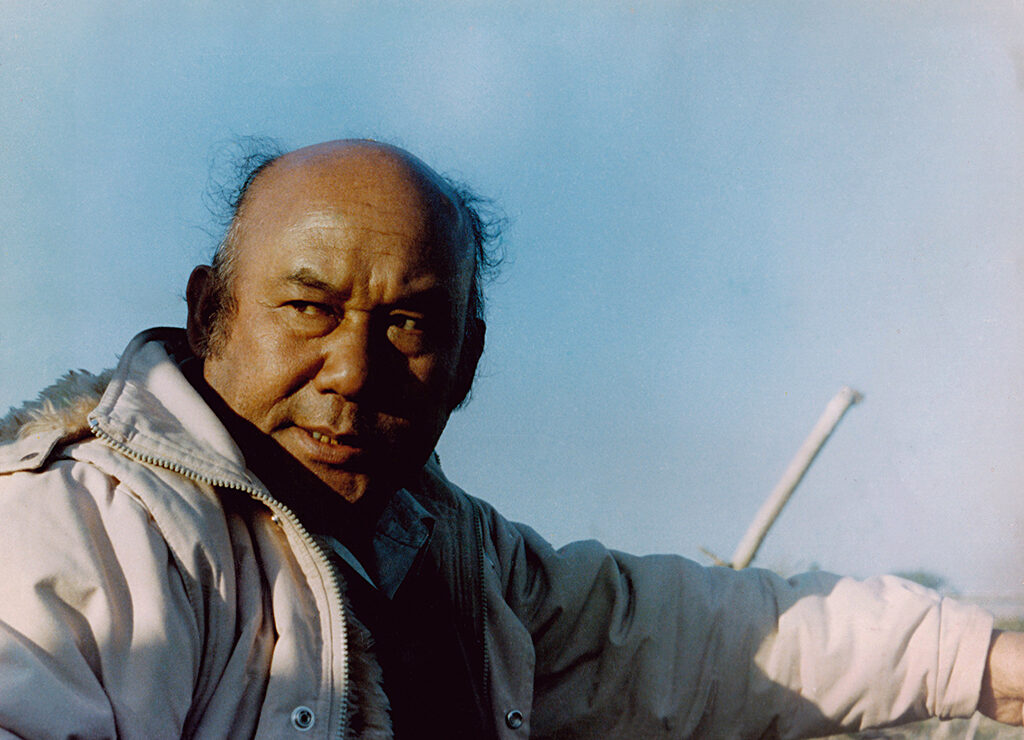
Aribam Syam Sharma, the acclaimed filmmaker from Manipur, has done it all. Actor, singer, composer, theatre director, filmmaker and champion of Manipuri cinema – he is a true Renaissance man who displayed a mastery over every genre of filmmaking from blockbusters to arthouse cinema to documentaries. In a career spanning close to fifty years, Syam Sharma has directed 15 feature films, over 40 documentaries and scored the music for 25 films. He also played a key role during his three-year stint at the Manipur Film Development Council and as the first Managing Director of the Manipur Film Development Corporation towards improving the infrastructure for film production and the creation of avenues for the appreciation of cinema in Manipur.
“I believe that as filmmakers, we need to return to our roots again and again to make films, which stand as works of art”, said Aribam Syam Sharma, whose films put Manipuri cinema on the world map. Known for his simple, poetic narratives about ordinary people, rooted in the culture of Manipur, Aribam Syam Sharma’s body of work has stayed true to this belief.
Born in 1936, Syam Sharma came to the world of cinema through music and drama. He composed and sang songs and acted in plays right from his school days. When he was in D.M. College, he formed the Amateur Artistes Association along with some friends, which became the forerunner of Roop Raag, the oldest musical association in the state founded in 1960 to promote modern Manipuri music. Syam Sharma graduated with a Masters in Philosophy from the storied Vishwa Bharati University in Santiniketan where he also studied Rabindra Sangeet. His time at Santiniketan had a profound impact on his artistic outlook and creative philosophy.
Syam Sharma’s first foray into film was as an actor and composer in the first Manipuri feature film “Matamgi Manipur” (1972). His debut feature was Lamja Parshuram (1974), which became the first film to run in the cinemas for over 100 days in Manipur. His second film Saaphabee,(1976) won him the first of many National Awards. The film Olangthagee Wangmadasoo (1979) marked the beginning of a long and successful creative collaboration between Syam Sharma and M.K. Binodini Devi, one of the daughters of Maharaj Churachand of Manipur and one of the greatest writers in the history of Manipur. The result was a film that continues to hold the record as the longest running Manipuri film so far in the history of Manipuri cinema with the record run of 32 weeks. Having directed a blockbuster and feeling confident that he done his part in Manipuri cinema making a mark at the box office, Syam Sharma decided to leave the mainstream behind. The result was “Imagi Ningthem” (1981) that made the world sit up and take notice. With Imagi Ningthem (1981), Syam Sharma became the first Indian recipient of the prestigious Montgolfière D’or at the Festival des Trois Continents, Nantes. His film Ishanou (1990) was selected in the Un Certain Regard section at the 44th Cannes International Film Festival. He has won multiple National Awards over the years for his films Saaphabee, Olangthagi Wangmadasoo, Imagi Ningthem, Ishanou, Sanabi and Leipaklei.
Each of his documentaries explored an aspect of the rich Manipuri culture. His National Film Award winning documentaries are: Deer on the Lake (1989), Indigenous Games of Manipur (!990), Meitei Pung(1991), Orchids of Manipur (1994),Yelhou Jagoi (1995), Thang-Ta: Martial Arts of Manipur (!991),The Monpas of Arunachal Pradesh (2001), Guru Laimayum Thambalngoubi (2006) and Manipur Pony(2012). Sangai: The Dancing Deer of Manipur was declared as the “Outstanding Film of the Year” in 1989 by the British Film Institute and won five awards at the 12th International Wildlife Film Festival in Montana, USA.
A doyen of Manipuri cinema, Syam Sharma was honoured with the Padma Shri in 2006 by the Government of India. Two years later, he was awarded the Dr. V. Shantaram Lifetime Achievement Award for his contribution to documentary filmmaking. His works have been screened at several international forums, like the British Film Institute, the Museum of Modern Art and Yamagata International Documentary Film Festival. In 2015, Syam Sharma was conferred with the Jewel of Manipuri Cinema by the Manipur State Film Development Society and the International Film Festival of India held a special retrospective of his works.
PICTURE GALLERY:
ISHANOU – RESTORATION TEAM AT THE RED CARPET OF CANNES CLASSICS 2023:
FILM COMPANION AT CANNES: EXCLUSIVE INTERVIEW WITH SHIVENDRA SINGH DUNGARPUR & KANGABAM TOMBA BY ANUPAMA CHOPRA
NEWS ARTICLES:
(Click on image to read the full article)




